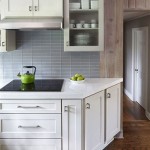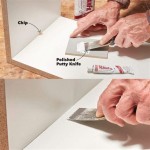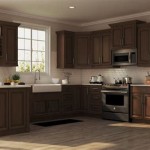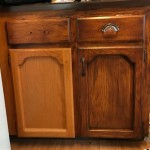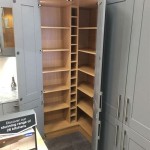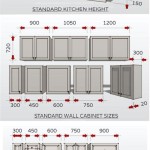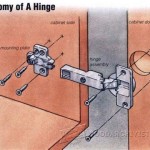Ideas for Open Space Above Kitchen Cabinets
The space above kitchen cabinets often presents a design challenge. It can appear as wasted potential, a void in an otherwise carefully planned room. Leaving it empty can result in a feeling of incompleteness, while haphazardly filling it with clutter can create an unorganized and visually jarring aesthetic. The key is to approach this area with intention, considering both its visual impact and potential functionality. This article explores various ideas for optimizing the space above kitchen cabinets, ranging from purely decorative solutions to those that offer practical storage or display opportunities.
Decorative Displays: Enhancing Visual Appeal
One of the most popular approaches to filling the space above kitchen cabinets is to utilize it for decorative displays. This option allows homeowners to inject personality and style into their kitchen without necessarily adding functional storage. The success of a decorative display hinges on creating a cohesive and visually appealing arrangement that complements the overall kitchen design.
Consider the kitchen's existing color palette and style. A monochromatic display, featuring various shades of a single color, can create a sophisticated and unified look. Alternatively, a display incorporating complementary colors can add a vibrant and dynamic element. For example, in a kitchen with blue cabinetry, displaying items in shades of orange or coral can create a visually striking contrast.
Repetition and scale are important considerations. Repeating a specific element, such as a particular shape or material, can create a sense of rhythm and visual harmony. Varying the scale of the objects displayed adds visual interest and prevents the display from appearing monotonous. Combining items of different heights, widths, and depths creates a more dynamic and engaging arrangement.
Examples of decorative items suitable for displaying above kitchen cabinets include:
*Vases and Pottery:
A collection of vases and pottery in varying shapes, sizes, and textures can add a touch of elegance and sophistication. Consider using vases in different materials, such as glass, ceramic, and metal, to create visual contrast. *Baskets:
Baskets offer a rustic and textural element. Woven baskets of different sizes and shapes can be arranged to create a visually appealing display. Consider filling the baskets with faux greenery or decorative items. *Artwork and Sculptures:
Small framed prints, paintings, or three-dimensional sculptures can add a personal touch and reflect the homeowner's artistic tastes. Ensure the artwork is properly scaled for the space and complements the existing kitchen décor. *Vintage Finds:
Antique dishes, vintage signs, or other collectible items can add character and charm to the kitchen. These items can be arranged to create a nostalgic and personalized display.Lighting can play a crucial role in enhancing the visual impact of a decorative display. Installing recessed lighting or under-cabinet lighting can illuminate the items on display, making them more prominent and visually appealing. The lighting can also create a warm and inviting ambiance in the kitchen.
Extended Storage: Maximizing Vertical Space
For homeowners seeking to maximize storage space in their kitchen, extending the cabinets upward is a practical and efficient solution. This approach involves either installing taller cabinets that reach the ceiling or adding a section of cabinets above the existing ones. This option effectively eliminates the unused space and provides valuable storage for items that are not frequently used.
When extending cabinets, consider the overall kitchen design and ensure the new cabinets blend seamlessly with the existing ones. Matching the style, color, and hardware of the existing cabinets is essential for creating a cohesive and unified look. Alternatively, consider using a contrasting color or finish for the upper cabinets to create a visually distinct section. This can be achieved by using glass-fronted cabinets, different door styles, or a different paint color.
The extended storage space can be used to store a variety of items, including infrequently used appliances, seasonal decorations, serving dishes, and cookbooks. It is important to organize the items in a logical and accessible manner. Using storage containers, baskets, and dividers can help to keep the cabinets organized and prevent clutter. Labeling the containers will further enhance organization and accessibility.
Consider the functionality of the extended storage space. If the space is primarily used for storing heavy items, ensure the cabinets are sturdy and well-supported. Installing adjustable shelves allows for flexible storage options and accommodates items of different sizes. Installing pull-down shelves can make it easier to access items stored in higher cabinets.
Careful planning is essential when extending cabinets. Measurements must be accurate and the installation must be performed by a qualified professional. Consider the placement of electrical outlets and plumbing fixtures when planning the extension. Ensure the new cabinets do not obstruct access to these features.
Themed Displays: Creating a Focal Point
Another creative approach involves curating a themed display above the kitchen cabinets. This allows homeowners to showcase their interests and create a unique focal point in the kitchen. A themed display can be tailored to reflect the homeowner's hobbies, passions, or travels.
Selecting a theme should align with the homeowner's personal tastes and the overall aesthetic of the kitchen. Some popular theme ideas include:
*Travel Memorabilia:
Displaying souvenirs, photographs, and artifacts from past travels can create a visually engaging and meaningful display. Consider incorporating maps, postcards, and small decorative items from different countries. *Cookbook Collection:
A collection of cookbooks, arranged by genre or author, can create a visually appealing and functional display. Consider using cookbook stands or shelves to showcase the covers of the books. *Plant Collection:
Displaying a collection of potted plants can add a touch of greenery and life to the kitchen. Select plants that thrive in the kitchen environment, such as herbs, succulents, or air plants. Different sized pots and stands will increase visual interest. *Vintage Kitchenware:
Displaying vintage kitchenware, such as antique scales, enamelware, and wooden utensils, can add character and charm to the kitchen. These items can be arranged to create a nostalgic and personalized display. *Holiday Decorations:
Rotating holiday decorations throughout the year can create a festive and seasonal ambiance. Store decorations in labeled containers and swap them out as each holiday approaches.When creating a themed display, consider the balance and visual harmony of the arrangement. Varying the sizes, shapes, and textures of the items on display prevents the display from appearing monotonous. Using a consistent color palette or material can create a sense of unity and cohesion.
Lighting can further enhance the visual impact of a themed display. Installing spotlights or track lighting can highlight specific items and create a dramatic effect. Consider using colored lighting to complement the theme of the display. For example, using warm-toned lighting for a display of vintage kitchenware can enhance its nostalgic appeal.
Maintaining the cleanliness of the display is essential. Dusting regularly and removing any cobwebs will ensure the display remains visually appealing and well-maintained. Periodically rearranging the display can also refresh its appearance and prevent it from becoming stale.
Functional Storage: Combining Aesthetics and Practicality
Combining decorative elements with functional storage offers a balanced approach to utilizing the space above kitchen cabinets. This option allows homeowners to enhance the visual appeal of the kitchen while also providing practical storage solutions. Selecting storage containers that are both aesthetically pleasing and functional is key to achieving this balance.
Opt for storage containers that complement the kitchen's design style. Wicker baskets, wooden crates, and metal bins can add texture and visual interest while also providing practical storage for items such as cookbooks, serving dishes, or pantry staples. Glass jars can be used to store dry goods, such as pasta, rice, or beans, while also showcasing their vibrant colors and textures.
Consider using open shelving to display frequently used items. Open shelves provide easy access to these items while also adding a decorative element to the kitchen. Arrange the items on the shelves in a visually appealing manner, grouping similar items together and varying their heights and depths. Consider adding decorative accents, such as framed photos or small plants, to enhance the visual appeal of the shelves.
Integrating lighting into the functional storage space can further enhance its visual appeal. Installing under-cabinet lighting can illuminate the storage containers and shelves, making them more prominent and visually appealing. Consider using lighting with adjustable brightness levels to create a customized ambiance.
Maintaining organization within the storage containers is essential. Labeling the containers clearly identifies their contents and makes it easier to find items when needed. Organizing the items within the containers by category or frequency of use further enhances accessibility and efficiency. Regularly decluttering the storage containers ensures they remain organized and clutter-free.
Consider the weight capacity of the cabinets when storing heavy items above them. Reinforcing the cabinets, if necessary, ensures they can safely support the weight of the storage containers and their contents. Distribute the weight evenly across the cabinets to prevent any damage or instability.
Creating a Coffered Effect: Architectural Enhancement
Transforming the space above cabinets into a coffered ceiling feature offers a sophisticated architectural enhancement. This involves constructing a grid-like pattern of recessed panels or beams above the cabinets, creating a three-dimensional visual effect. This approach is especially effective in kitchens with high ceilings, adding depth, texture, and a sense of grandeur.
The design of the coffered ceiling should complement the overall architectural style of the kitchen and the home. For traditional kitchens, a classic coffered design with intricate moldings and detailing is appropriate. In modern kitchens, a simpler, more geometric design with clean lines and minimal ornamentation may be preferred.
Materials used for the coffered ceiling can vary depending on the desired aesthetic. Painted wood is a common choice, offering a timeless and versatile look. Stained wood can add warmth and richness to the space, while metal or composite materials can create a more contemporary appearance.
Proper lighting is crucial for highlighting the coffered ceiling's architectural details. Recessed lighting within each coffer can illuminate the panels and create a dramatic effect. Pendant lights or chandeliers suspended from the ceiling can add additional illumination and visual interest. Consider using dimmable lights to adjust the ambiance and create different moods.
The height of the cabinets and the ceiling height are important considerations when planning a coffered ceiling. Ensure there is sufficient space above the cabinets to accommodate the coffered structure without making the ceiling feel too low or crowded. Carefully calculate the dimensions of the coffers to create a balanced and visually appealing pattern.
Constructing a coffered ceiling is typically a more involved project that may require professional assistance. It is essential to consult with a qualified contractor or carpenter to ensure the structure is properly designed and installed. Accurate measurements, precise cuts, and secure attachment are crucial for creating a durable and aesthetically pleasing coffered ceiling.

7 Trendy Ways To Decorate The Empty Space Above Kitchen Cabinets Neutrally Nicole

Filling In That Awkward Space Above The Cabinets Kitchen Progress Inspired Room Empty
:strip_icc()/101634871-9532042e1719420b859d6d4d4b732be3.jpg?strip=all)
16 Ideas For Decorating Above Kitchen Cabinets

14 Ideas For Decorating Space Above Kitchen Cabinets How To Design Spot
:strip_icc()/101705919-46c69aadc4b1401fbb8383b607c37b36.jpg?strip=all)
16 Ideas For Decorating Above Kitchen Cabinets

Decorate Above Kitchen Cabinets The Crazy Craft Lady

14 Ideas For Decorating Space Above Kitchen Cabinets How To Design Spot

How To Decorate Above Kitchen Cabinets Modern Farmhouse

14 Ideas For Decorating Space Above Kitchen Cabinets How To Design Spot

Closing The Space Above Kitchen Cabinets Remodelando La Casa
Related Posts

